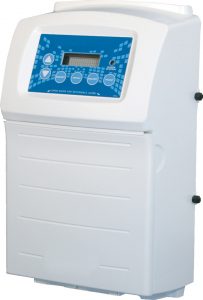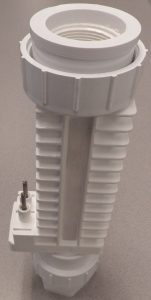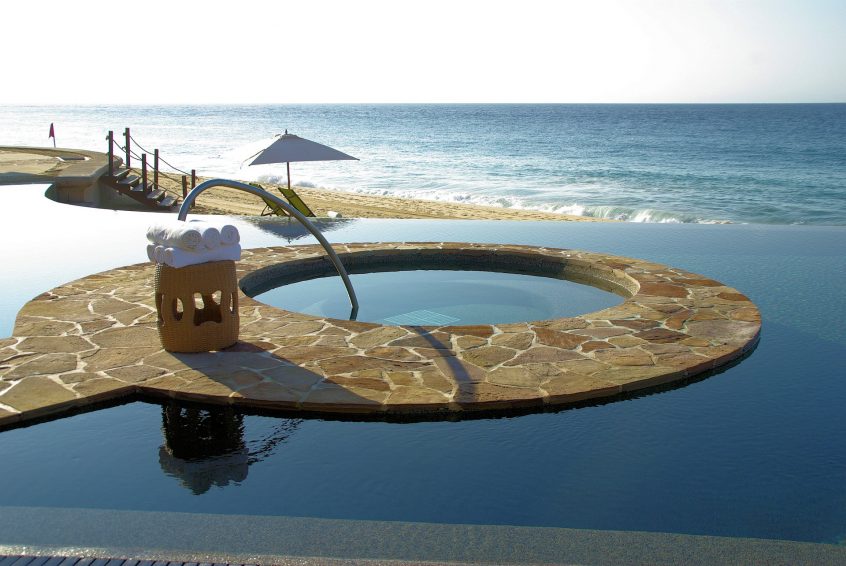One of the fastest growing accessories in the swimming pool and spa industry are electrolytic chlorine generators (ECGs), which also go by the name of salt chlorine generators (SCGs), saltwater chlorinators and saltwater generators. They all do the same thing—produce chlorine onsite. The popularity of this sanitation method is increasing in both the residential and commercial pool/spa markets; however, there is a lack of understanding in terms of how these systems work, how they are maintained and how to properly diagnose and troubleshoot a system to ensure successful operation year after year.
What is an ECG?
An ECG operates using several components, including a control unit, electrolytic cell, flow switch and salt.
Control unit

The control unit regulates the amount of chlorine produced, provides system diagnostics, and in some cases, it provides control of the circulation pump.
Electrolytic cell

The electrolytic cell houses the system’s titanium blades, which have a typical lifespan of 10,000 hours (residential pools) and 15,000 hours (commercial pools).
Flow detection
According to UL Standards 1081, Swimming Pool Pumps, Filters, and Chlorinators, a flow detection device must be designed into the ECG. The two acceptable methods for flow detection are mechanical flow switches or electronic gas traps. A flow switch places a flat paddle in the stream of water and pushes it to activate a micro switch when there is sufficient flow.
A gas trap uses the water’s conductivity to close the circuit between two points within the cell. When there is insufficient flow, gas generates within the cell body and opens the circuit between the two points, shutting off power to the cell.
Salt
The most important component, salt, or sodium chloride (NaCl), is added for two reasons. First, it increases conductivity in the water to create the electrolytic reaction, and secondly, it is the source from which chlorine is generated.
The electrolytic process generates hypochlorous acid (HClO) to create sustainable chlorine residuals by recombining sodium to chloride. During this ongoing process, salt does not diminish; it is reusable, making this an efficient method of water sanitation.
Further, this process generates chlorine at a high concentration within the cell, providing efficient and effective treatment of water passing through the cell. At this point, breakpoint chlorination is also reached, which eliminates the negative effects of chloramines (NH2Cl) caused by chlorine reacting to bather waste (e.g. body oils, cosmetics, suntan lotions, perspiration, urine, etc.). The result is better water quality, and in the case of indoor pools, air quality as well.
Salt levels should be tested quarterly and/or after heavy rainfall. For winterized pools, levels should be tested at the beginning of the season and at least once during the season.
Since salt is not lost by evaporation, it should not fluctuate too much. If salt test levels are inconsistent with the salt display on the control unit, it should be calibrated to match the test results (if possible). Keep in mind, some systems provide a salt-level estimate, based on the amps and volts to the cell, which are influenced by water temperatures and remaining cell life (lower salt level displayed). In cold temperature conditions, or with an older cell, salt levels should be verified first by testing the water prior to adding more salt.
| A LOOK AT NON-RELATED SALT SYSTEM PROBLEMS |
|---|
| Typical complications that can occur in saltwater swimming pools/spas, which are not related to the electrolytic chlorine generator (ECG) are generally caused by environmental or operational conditions.Stabilizer Problem: Insufficient chlorine (Cl) production (outdoor pools). Solution: For outdoor pools, a stabilizer (cyanuric acid) should be added to help prevent the sun’s ultraviolet (UV) rays from breaking down free chlorine in the pool/spa. The recommended range is 50 to 80 parts per million (ppm), 30 to 50 ppm for oxidation reduction potential (ORP) controlled systems.Phosphates (PO43−) and nitrates (NO−3) Problem: High chlorine demand caused by excessive levels of phosphates and nitrates, which help algae grow. Solution: Lanthanum (La) and aluminum (Al) based specialty chemicals are two effective treatments for removing phosphates from pool/spa water, while ridding the pool/spa of nitrates requires diluting the water. As a rule of thumb, always treat the algae first, then deal with phosphate issues. The reason for this is algae will release more phosphates into the water as it dies off, which means the pool/spa will require another phosphate treatment.Sodium thiosulfate (Na2S2O3) Problem: High chlorine demand caused by adding too much chlorine neutralizer. Solution: Chlorine neutralizer is a potent product used to lower chlorine levels (typically in commercial pools). Performing a shock treatment (mixing a large amount of sodium hypochlorite [NaOCl] into the water) will satisfy the chlorine demand and bring the pool/spa back to normal operating conditions.Sodium bromide (NaBr) Problem: Sodium bromide, or bromine salt (the main ingredient in most specialty algaecides with ‘yellow’ or ‘mustard’ in the name) causing the salt system to generate low-dosage bromine, overtaking the chlorine process. Solution: Using as little as 0.9 kg (2 lbs) of a product containing sodium bromide can cause this conversion to take place. One way to avoid this from happening is to turn off the salt system and manually add chlorine to increase levels to 5 to 10 parts per million (ppm). Continue adding chlorine in this manner on a regular basis to maintain the appropriate sanitizer level. Once the sanitizer level can be maintained for three to four days, without needing to manually add more chlorine, turn the salt system back on. This process should take approximately two weeks. |
General maintenance advice
Testing chlorine levels periodically will help to ensure the ECG is properly adjusted. Bear in mind, overall water chemistry should also be routinely tested to ensure the water is properly balanced. By using the Langelier Saturation Index (LSI), a calculated number used to predict the calcium carbonate (CaCO3) stability of water, the water’s corrosive or scaling tendencies can be determined.
Control unit
Each manufacturer provides different types of diagnostics and control features on its ECG control units. Some provide digital displays, while others provide light-emitting diode (LED) displays. Warning messages and error codes displayed on the control unit should be utilized, along with the system’s owner’s manual, to diagnose problems. Those who are comfortable working with electronics can inspect the circuit boards for damaged fuses and burnt boards.
Watch for scale
The cell should be removed periodically and inspected for calcium scale formation on the titanium blades. Scale formation is the worst condition for the cell to operate under as it depletes the Ruthenium Oxide coating the quickest.
Other reasons, which may cause the cell to fail, include improperly connected or damaged cell cords or expired cells.Scale forms under two conditions—malfunction of the cell’s self-cleaning operation (reverse polarity) and improper water chemistry. One way to determine the cause of scale formation can be determined by how quickly it is forming. For instance, a cell showing scale buildup within one week of operation is typically a system where the reverse polarity function is not operating properly. If scale forms after more than two weeks, it is generally water balance related. Removing calcium scale buildup on the cell is discussed later.
Test pH often
Although pH in a saltwater pool is near neutral, there is still a tendency for it to drift upward, around 8.2. Therefore, frequent pH testing and adjustments are highly recommended to ensure proper chlorine strength and appropriate water balance.
Managing salt loss
Salt and cyanuric acid (CNOH)3 are lost from leaks, filter backwashing, rainwater overflow (outdoor pools) and bather splash out. Salt is not lost during pool/spa water evaporation. If salt needs to be added to the water to maintain the recommended levels, cynauric acid should be added at the same time.
Handy service tips
There is little service required to ensure the continuous, trouble-free operation of an ECG. However, should issues occur, the following tips will help troubleshoot some of the most common problems:
Low flow
Problem: Power to the cell shuts off when flow is insufficient to evacuate chlorine and gases produced within the cell.
Solution: Ensure pump and skimmer baskets are clean, filters cleaned/backwashed, and all valves are properly positioned. Any one of these situations can cause low flow conditions. Minimum flow requirements are different between each manufacturer; therefore, it is important to check the manufacturer’s specifications. Caution must be observed with multi-speed pumps to ensure proper flow. Other common causes of flow errors include improper or damaged wire connections and defective flow switches.
Scaled cells
Problem: Scale formation on the cell caused by water balance issues or self-cleaning (reverse polarity) malfunction.
Solution: Clean the cell with an acid wash treatment, using four parts water and one part muriatic acid. Remove any electrical cords and soak the cell in an acid wash treatment. The cell should soak for a maximum of 20 minutes or until the effervescent action stops. Then, rinse the cell with fresh water and dry any electrical terminals.
Low conductivity
Problem: Chlorine production becomes insufficient (affected by low salt, cold water and/or scaled cells), causing premature wear on the cell.
Solution: For low salt, test the water, adjust the salt level and calibrate the control unit as required. Consistent low salt warnings indicate a leaking pool, worn cell or defective salt sensor. In cold water, as temperatures start to fall, the amperage and voltage to the cell will adjust to compensate; however, this can also falsely indicate a low-salt condition. Depending on the manufacturer, some ECGs will automatically shut down to protect the system in cold water conditions. For these systems, it is necessary for chlorine to be added to the pool/spa manually. In some cases, increasing salt levels to the upper limit of the manufacturer’s recommended range will allow extended operation before shut down. Finally, for scaled cells, see the problem/solution as previously discussed.
Pump run time
Problem: Too much or too little chlorine production due to inadequate pump operation settings.
Solution: ECGs are rated at a specific amount of chlorine production per day; therefore, the pump must run enough hours per day to generate a sufficient amount of chlorine to maintain adequate sanitizer levels in the pool/spa. Most ECGs have a percentage setting, which controls how much chlorine they produce while the pump is running. Chlorine production can be increased/decreased by raising/lowering this percentage. An ECG should not be expected to produce enough chlorine to maintain a large pool if the pump is only operating four hours per day.
The value of knowledge
Having the knowledge of proper ECG operation and maintenance is critical for pool and spa service professionals—especially with consumer demand for these systems rapidly increasing. By attending local training courses offered by various ECG manufacturers, the differences between each system can be better understood. The more knowledge a service professional has about ECG systems, and saltwater pools in general, the more valuable they are to their customers.
This article was written by Sean Assam and originally appeared on Pool & Spa Marketing [link].
